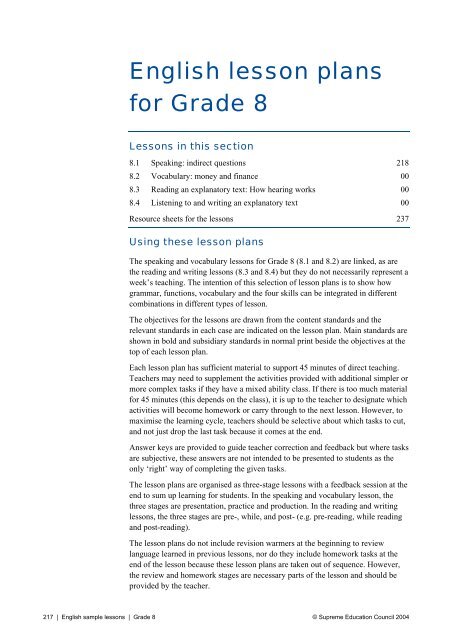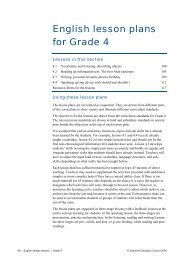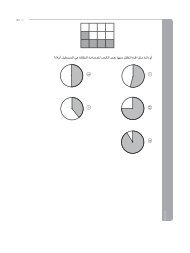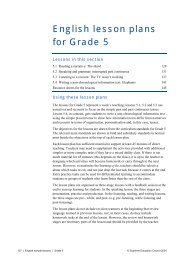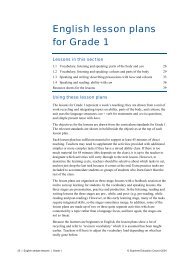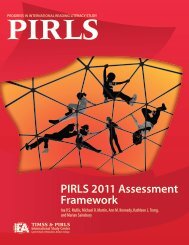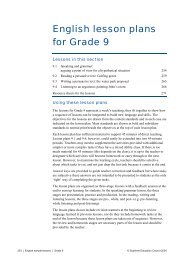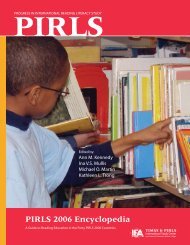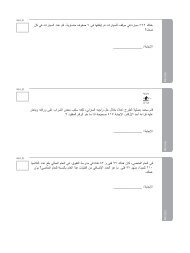English lesson plans for Grade 8
English lesson plans for Grade 8
English lesson plans for Grade 8
You also want an ePaper? Increase the reach of your titles
YUMPU automatically turns print PDFs into web optimized ePapers that Google loves.
<strong>English</strong> <strong>lesson</strong> <strong>plans</strong><strong>for</strong> <strong>Grade</strong> 8Lessons in this section8.1 Speaking: indirect questions 2188.2 Vocabulary: money and finance 008.3 Reading an explanatory text: How hearing works 008.4 Listening to and writing an explanatory text 00Resource sheets <strong>for</strong> the <strong>lesson</strong>s 237Using these <strong>lesson</strong> <strong>plans</strong>The speaking and vocabulary <strong>lesson</strong>s <strong>for</strong> <strong>Grade</strong> 8 (8.1 and 8.2) are linked, as arethe reading and writing <strong>lesson</strong>s (8.3 and 8.4) but they do not necessarily represent aweek’s teaching. The intention of this selection of <strong>lesson</strong> <strong>plans</strong> is to show howgrammar, functions, vocabulary and the four skills can be integrated in differentcombinations in different types of <strong>lesson</strong>.The objectives <strong>for</strong> the <strong>lesson</strong>s are drawn from the content standards and therelevant standards in each case are indicated on the <strong>lesson</strong> plan. Main standards areshown in bold and subsidiary standards in normal print beside the objectives at thetop of each <strong>lesson</strong> plan.Each <strong>lesson</strong> plan has sufficient material to support 45 minutes of direct teaching.Teachers may need to supplement the activities provided with additional simpler ormore complex tasks if they have a mixed ability class. If there is too much material<strong>for</strong> 45 minutes (this depends on the class), it is up to the teacher to designate whichactivities will become homework or carry through to the next <strong>lesson</strong>. However, tomaximise the learning cycle, teachers should be selective about which tasks to cut,and not just drop the last task because it comes at the end.Answer keys are provided to guide teacher correction and feedback but where tasksare subjective, these answers are not intended to be presented to students as theonly ‘right’ way of completing the given tasks.The <strong>lesson</strong> <strong>plans</strong> are organised as three-stage <strong>lesson</strong>s with a feedback session at theend to sum up learning <strong>for</strong> students. In the speaking and vocabulary <strong>lesson</strong>, thethree stages are presentation, practice and production. In the reading and writing<strong>lesson</strong>s, the three stages are pre-, while, and post- (e.g. pre-reading, while readingand post-reading).The <strong>lesson</strong> <strong>plans</strong> do not include revision warmers at the beginning to reviewlanguage learned in previous <strong>lesson</strong>s, nor do they include homework tasks at theend of the <strong>lesson</strong> because these <strong>lesson</strong> <strong>plans</strong> are taken out of sequence. However,the review and homework stages are necessary parts of the <strong>lesson</strong> and should beprovided by the teacher.217 | <strong>English</strong> sample <strong>lesson</strong>s | <strong>Grade</strong> 8 © Supreme Education Council 2004
8.1Objectives<strong>Grade</strong> 8 curriculumstandards 5.14, 5.15,5.19PresentationResourcesOHT 8.1aVocabulary(to) check ina rowan aislethe gatethe duty free(to) reconfirmSpeaking: indirect questions• Use indirect questions Can/Could you please tell me …, Do you know … to ask<strong>for</strong> in<strong>for</strong>mation politely, and respond with Certainly; No, I’m sorry …• Use indirect questions accurately by (a) securing word order Can you pleasetell me where the check-in counter is? and (b) using if <strong>for</strong> yes/no questions Doyou know if the flight’s on time?NetworksSet the scene: at the airport. Elicit as much airport vocabulary as possible thatstudents know already with a network on the board.(to) check inAt the airporta passengerthe gatea flightleft luggageOrderingPre-teach the vocabulary and check understanding by getting students to order thewords in a typical chronological sequence of someone who is returning home byplane after a holiday in the UK.A few days be<strong>for</strong>e leaving reconfirm your flight.Check in.Ask <strong>for</strong> an aisle seat.Go to the duty free to buy gifts <strong>for</strong> your family.Go to the gate.Find the right row.Dialogue buildGive the students the jumbled skeleton dialogue between a passenger and anairport official on OHT 8.1a. Get them to order it.Answer keyQatar Airways to Dubai?Thanks.Time <strong>for</strong> duty free?Flight full?Rows 17 to 19 over there.Hurry up. The gate’s closing.No. Final call.Don’t know.218 | <strong>English</strong> sample <strong>lesson</strong>s | <strong>Grade</strong> 8 © Supreme Education Council 2004
Get students to use the cues to create a conversation. Get them to practise theirconversations in pairs. When they’ve done it a few times, swapping roles, givethem the following in<strong>for</strong>mation.Teacher’s scriptAs well as being very late, the passenger has 25 kilos more than he is supposedto have, doesn’t want to be charged extra and still wants to go to the duty freeto do some shopping. He has to be very polite to the airport staff in order toget these things done.Build up the following dialogue by eliciting and improving questions and answersfrom the cues and inputting the indirect question <strong>for</strong>m. Get students to repeat eachline of the dialogue chorally and individually from the cues be<strong>for</strong>e writing up thewhole sentence on the board. When it’s complete, get them to practise it in pairs.Have them copy it into their exercise books.Passenger:Airport official:Passenger:Airport official:Passenger:Airport official:Passenger:Airport official:Could you please tell me where the check-in desk <strong>for</strong>Qatar Airways is?Certainly. Rows 17 to 19 over there.Thank you so much.You’d better hurry. The gate’s closing.Do you know if I’ve got time to go to the duty free?Not really. It’s the final call.Can you tell me if the flight’s full?I’m sorry but I’m afraid I don’t know.Concept checkAsk the following concept-checking questions to check students understand whento use indirect questions and how to construct them.• Is the passenger being polite or familiar? Polite• Formal or in<strong>for</strong>mal? Formal• Why? The airport official is a stranger; the passenger wants the him or her todo him or her a favour.• Which phrases does the passenger use at the beginning of the questions tomake them more polite? Could you please tell me …? Can you tell me …?Do you know …?• In a direct question, what would you say <strong>for</strong> the first question? Where’s thecheck-in desk?• Verb be<strong>for</strong>e subject or subject be<strong>for</strong>e verb? Verb be<strong>for</strong>e subject: Where isthe check-in desk?• Our passenger uses an indirect question to be polite. In this type ofquestion, is it subject be<strong>for</strong>e verb or verb be<strong>for</strong>e subject? Look at thedialogue. Subject be<strong>for</strong>e verb: … where the check-in desk is.• Is it still a question? Yes• Is the first question a wh-type question or a yes/no question? A wh-typequestion• Look at the second two questions. What about them? Yes/no questions• What extra word is put into the indirect question <strong>for</strong> yes /no questions? If219 | <strong>English</strong> sample <strong>lesson</strong>s | <strong>Grade</strong> 8 © Supreme Education Council 2004
PracticeResources2 copies each ofWorksheet 8.1• How does the airport official say ‘Yes’ politely in the first question?Certainly• How does the airport official say ‘No’ politely in the second two questions?Not really …, I’m sorry but I’m afraid I don’t know.• Which ‘no’ is the most polite?‘ I’m sorry but I’m afraid I don’t know.Trans<strong>for</strong>mation drillOrally, you give the class a sentence. They trans<strong>for</strong>m it into an indirect question.Practise the first three cues with Can you tell me …?, the second three with Couldyou please tell me …? and the last three with Do you know …?Teacher saysYou need to find the transit lounge.You need to buy presents <strong>for</strong> yourfamily.You need to take your baggage trolleydownstairs.You need to check in to British AirwaysYou need to change money.You need to find Gate 22.You need to send an email.You need to know how many kilos youcan take.You need to reconfirm your flight but youdon’t know when.Students sayCan you tell me where the transit lounge is?Can you tell me where the duty free is?Can you tell me where the lifts are?Could you please tell me where the BritishAirways check-in desk is?Could you please tell me if there’s a banknear here?Could you please tell me where Gate 22 is?Do you know if there’s an internet terminalnear here?Do you know what the baggage allowance is?Do you know when I should reconfirm myflight?In<strong>for</strong>mation gapGet students to complete the floor plan <strong>for</strong> Terminal One on worksheet 8.1.Working individually, have them decide where the items listed below the <strong>plans</strong>hould go and get them to fill in one of their floor <strong>plans</strong> accordingly. Each studentshould come up with a slightly different layout. Put them in pairs. Student A is anairport official, and has his or her completed floor plan of the airport. Student B isa passenger and uses the second (unfilled-in) floor plan of the airport. Get thepassenger (Student B) to ask the airport official (Student A) where all the listedplaces are, using polite, indirect questions, and fill in the floor plan. Demonstratewhat to do with one student in front of the class be<strong>for</strong>e getting students to practisein closed pairs.Teacher: Could you please tell me where the check-in desk <strong>for</strong> Emirates is?Student : Certainly, sir. It’s over there on the left: row 4, next to QatarAirways.[Teacher writes in Emirates in the box numbered 4 next to Qatar Airways onthe floor plan and shows the class]Monitor and correct <strong>for</strong> accuracy. When Student B has completed his or her secondfloor plan, the pair swap roles and Student A asks questions in order to fill in theirsecond floor plan.220 | <strong>English</strong> sample <strong>lesson</strong>s | <strong>Grade</strong> 8 © Supreme Education Council 2004
ProductionResourcesOHT 8.1bMapped dialogueUse the mapped dialogue on OHT 8.1b to get students to role play a politeconversation, asking <strong>for</strong> in<strong>for</strong>mation on the telephone, between a passenger and aflight reservations clerk. Elicit some ideas <strong>for</strong> each of the cues. Remind studentsto use the indirect question <strong>for</strong>m as well as polite offers and requests, Would youlike …? and I’d like … Get students to practise in pairs and then swap roles.PassengerGood morning. I’d like to reconfirm myticket.[gives name]Yes, of course. It’s QR302 to London.It says the 27 th of November at 20:25.Could you please tell me what thereconfirmation number is?Yes, why not?A window seat please.Vegetarian please. Can you tell me whatthe check-in time is?And could you please tell me what mybaggage allowance is?Thanks a lot.Thank you. Bye.Reservations clerkCertainly. Could you please tell me what yourname is?Thank you. And do you know what the flightnumber is?Right. And can you tell me what the date anddeparture time on the ticket says?Fine. You’re flight’s confirmed.Certainly. It’s XR72359RF.Would you like to reserve your seat now?Would you like an aisle or a window seat?And what about meals? Would you prefervegetarian, Halaal or regular?It’s two hours be<strong>for</strong>e, so that will be 6:25 inthe evening.20 kilos and you can take up to 7 kilos handluggage.Not at all. Have a good flight.Bye-bye.FeedbackMonitor <strong>for</strong> accuracy and some degree of fluency, encouraging students to gobeyond the frame and change in<strong>for</strong>mation or questions as they wish. Make a noteof good conversations as well as common errors <strong>for</strong> the feedback session, but don’tinterrupt the flow.Deal with most common spoken errors orally.221 | <strong>English</strong> sample <strong>lesson</strong>s | <strong>Grade</strong> 8 © Supreme Education Council 2004
Summary <strong>for</strong> studentsWe use indirect questions to be polite or more <strong>for</strong>mal. Being too direct sometimessounds rude in <strong>English</strong>. If we put more rising and falling intonation into theindirect question, it becomes even more polite. In <strong>English</strong>, we tend to be polite or<strong>for</strong>mal with strangers and especially with strangers when we want them to dosomething <strong>for</strong> us.Indirect questions start with Can … or Could you please tell me … or with Do youknow … The word order after this phrase is more like <strong>for</strong> a statement than aquestion: … where Gate 22 is?, … what time the plane takes off’? (In directquestions, we put the verb be<strong>for</strong>e the subject: Where is gate 22?, and we useauxiliary verbs such as does: What time does the flight take off?). If it’s a yes/noquestion, we use the word if after the opening question phrase: Can you please tellme if …?, Do you know if …? Sometimes, you’ll hear people use whether insteadof if: Can you please tell me whether it’s necessary to reconfirm my flight (or not)?To make the response as polite as the indirect question, we say Certainly, Ofcourse, I’m not sure, I’m afraid not, instead of a plain Yes or No, just as you’velearned <strong>for</strong> responding to polite requests.222 | <strong>English</strong> sample <strong>lesson</strong>s | <strong>Grade</strong> 8 © Supreme Education Council 2004
8.2Vocabulary: banking andfinanceObjectives<strong>Grade</strong> 8 curriculumstandards 1.2, 5.4, 5.19PresentationVocabularyfinancethe firman investmenta loan(to) guaranteeinsurancea policypropertyinteresta ratethe balancea budgetan expensean incentivea scheme(to) transfer(to) withdrawfundssavingsa surplus• Learn and use banking and finance vocabulary.• Get further practice in using indirect questions <strong>for</strong> politeness and <strong>for</strong>mality.PyramidIntroduce the topic ‘banking and finance’ with a pyramid brainstorm: workingindividually, students write down on a piece of paper all the words they know to dowith money, banking and finance. After a few minutes, stop them and get them toshare their list with a partner, copying down any new words and building up a jointlist. Repeat the process putting two pairs together, then two groups of four, thentwo groups of eight. Collate all the words into one class list on a poster, the OHTor the board, by getting the group with the longest list to write up their words andthe other group(s) to add any other words, no repetitions.Pre-teach vocabularyPre teach only the vocabulary remaining on your list which hasn’t already come upin the pyramid. Use a selection of the vocabulary practice techniques that follow tohelp students memorise and contextualise the new words. Change the target wordsin the activities to suit the real needs of your students.What and whereElicit the nouns below, one at a time, checking students can pronounce themcorrectly and writing them on the board. Draw a box or ‘file’ around each one:InsuranceLoansPropertySavingsInvestmentsBudgetPracticeWhen all the words are on the board, get students to repeat them as you point tothem. Rub out one of the words but do not rub out its box. Get students to repeatthe words again, including the rubbed-out word, by pointing at the boxes in randomorder, including the empty box. Rub out another word but leave the box. Getstudents repeat the words again, reading aloud what’s on the board or remembering223 | <strong>English</strong> sample <strong>lesson</strong>s | <strong>Grade</strong> 8 © Supreme Education Council 2004
what’s just been rubbed out. Continue until all the boxes are empty. Students nowhave to remember and say aloud all the words. You can elicit the words by asking‘What did we put in this file?’ (‘The budget’). ‘And in this one?’ (‘Savings’).When the words have been memorised and practised enough, check spelling bygetting students to come to the board and fill in the boxes with the correct words inthe correct boxes.Guessing gameElicit five or six banking and finance verbs (some of the target vocabulary plus afew known verbs) and write them up on the board in a list.startopentransferinvest inwithdrawElicit five or six banking and finance nouns and write these in a second list.startopentransferinvest inwithdrawa firman accountsavingspropertyOn a small piece of paper, get students to complete the sentence stub with one verbfrom the first list and one noun from the second list:I’ve just …I’ve just transferred my savings.In groups, students take it in turns to guess each other’s sentences using yes/noquestions.A: Have you just opened an account?B: No, I haven’t.C: Have you just invested in property?B: No, I haven’t.D: Have you just transferred your savings?B: Yes, I have.The one who guesses correctly is the next one up.Noughts and crossesRemind students of indirect questions with Do you know …? and Can you tellme …? In teams or pairs, get students to play noughts and crosses with thefollowing words. The first to have three noughts or three crosses in a row, wins.224 | <strong>English</strong> sample <strong>lesson</strong>s | <strong>Grade</strong> 8 © Supreme Education Council 2004
the surplus the policy the balancethe investment the funds the budgetthe rate the expenses the incentive schemeTo win a nought or a cross, students have to say which square they want by callingout the word written there and then making an indirect question with it.Team X, Student 1 The surplus. Can you tell me how much the surplus was?Team 0, Student 1 The funds. Do you know where the funds are invested?Team X, Student 2 The balance.: Do you know what the balance came to?Etc. 0 the surplus the policy the balancethe investment the funds the budgetthe rate the expenses the incentive schemeProductionResourcesTwo copies per group ofWorksheet 8.2BrainstormTell students they are going to design their own small firm. It can be anything.Suggest some usual and unusual companies.a travel agency, a software development company, a vet’s clinic, a gardeningstore, a hot-air balloon company, a dot com, a catering company, a gym,a garageIn groups of three, get students to design their company:• in general – its name, the type of business it is; briefly explain what it does• specifically – how the company’s finances work by filling in the <strong>for</strong>m inworksheet 8.2.RoleplayWhen they have filled in the details, tell them they are about to be audited by thetax authorities to see if they have to pay more tax or not. The <strong>for</strong>m they have justfilled in will provide the in<strong>for</strong>mation the auditors need. Put two groups together.Get one group to audit another. The auditors have to ask polite questions about allthe categories on the <strong>for</strong>m. Remind students they should use Can you tell me …?,Do you know …? questions to be polite and <strong>for</strong>mal. They can vary these questionphrases with others such asCould you explain (to me) …?225 | <strong>English</strong> sample <strong>lesson</strong>s | <strong>Grade</strong> 8 © Supreme Education Council 2004
FeedbackI’d like to find out …?Do you /Can you remember …?What I need to know is …As they ask these questions, they fill in the details of the firm they are auditing on asecond, blank copy of worksheet 8.2Could you please tell me what the name of the firm is?Could you explain what type of business that is?Do you remember what the original investment was?Can you tell me if you took out a bank loan? etc.Get students to conclude their roleplay with the auditors deciding if the companyshould pay more tax or not. Then, if there’s time, get them to swap roles and repeatthe process, so that both sides have the chance to ask and answer. Monitor and takenotes, recording good ideas and utterances and most common errors, withoutinterrupting the roleplays. Reiterate target language or instructions with any groupswhere a breakdown occurs.In plenary, comment on some of the companies you thought were well designedand who the toughest auditors were. Find out which companies have to pay moretax and get the auditors to explain why. Deal with the most common errors, orally.Summary <strong>for</strong> studentsGet students to tell you what new vocabulary they remember from the <strong>lesson</strong>.Briefly elicit that indirect questions were used in this context because the situationrequired <strong>for</strong>mality, distance and politeness by using some of the followingquestions:• Is an auditor your friend? No.• Why is it important to keep a <strong>for</strong>mal distance with official matters of financeand business? For ‘transparency’, lack of corruption, being ‘proper’. (Discussthese things in Arabic).• What is the grammar and what are the phrases you used to keep this distance?Indirect questions; word order; use of if with yes/no questions; phrases such asDo you know …?, Could you please tell me …? Could you explain (to me) …?,I’d like to find out …?, Do you /Can you remember …?, What I need to knowis … and replies such as Certainly, Of course, I’m afraid not.226 | <strong>English</strong> sample <strong>lesson</strong>s | <strong>Grade</strong> 8 © Supreme Education Council 2004
8.3Reading an explanatorytext: How hearing worksObjectives<strong>Grade</strong> 8 curriculumstandards 7.4, 6.6, 8.4Pre-readingResourcesLearner dictionariesWorksheet 8.3aexercise 1Vocabularyair particlesthe atmospherepressure(to) vibrate; vibration(to) resonate; resonance(to) amplify; amplificationpitcha tuning <strong>for</strong>kan eardruma tubea coila nervea fibrea fluidWhile readingResourcesWorksheets 8.3b and8.3a exercise 2• Read and understand the main idea and details of an explanation of howhearing works.• Discover and quantify the features of an explanatory text.Gap-fill vocabularyGet students to work in groups of five. Divide up the new vocabulary so that eachmember of the group has 2–3 words. Get them to look up their assigned words intheir dictionaries and find the Arabic translation (in the context of how hearingworks). Then, working as a group, get them to take it in turns to explain themeanings of their words.OrderingIn the same groups, give students worksheet 8.3a and get them to do exercise 1:order the process of hearing in the way they think it occurs. Tell them they’ll comeback to this and check the order after reading.Answer keyThe inner ear structure changes the vibrations into electrical signals. 7Sound travels through the air in waves of air pressure. 1The sound waves make the eardrum move backwards and <strong>for</strong>wards. 4The brain understands the electrical signals and knows if the sound is loud or soft,high or low, etc.The sound waves travel down the ear canal. 3A nerve carries the electrical signals to the brain. 8The outer ear directs the sound waves into the ear. 2A group of tiny bones in the middle ear amplify the sound waves. 5The increased pressure of the waves move the liquid inside the inner ear. 6Jigsaw readingIn the same groups, give each group member a number from one to five. Tell themthat they will read the section of the text corresponding to their number and thenexplain it in their own words to the other members of the group. Hand out the texton worksheet 8.3b and give students three minutes to read their section. Whenthey’ve finished reading, get them to explain their section in order, starting withsection one and ending with section five. Then get them to go back and check theiranswers <strong>for</strong> the pre-reading task.9Reading comprehensionStill working in their groups, get them to complete exercise 2 on worksheet 8.3aor save this <strong>for</strong> homework.227 | <strong>English</strong> sample <strong>lesson</strong>s | <strong>Grade</strong> 8 © Supreme Education Council 2004
Answer keycompression and rarefaction of air particlestympanic membranepinnaossiclesmalleusincusstapescochleainertiasound wavesthe eardrumthe outer earbones in the middle earthe hammerthe anvilthe stirrupthe inner earability not to be movedPost-readingResourcesWorksheets 8.3b, 8.3cText analysis: guided discoveryTell the whole class that this type of reading text is an explanatory text – it explainshow something works, in this case – the ear. An explanatory text has certainfeatures. The exercises on worksheet 8.3c will help them discover what thesefeatures are. Get them to work in their groups of five again and get them to divideup the tasks on the worksheet so they’re all doing something different. Forexample, the first student does exercises 1–3, the second student does exercises 4and 5, the third student does exercise 6 and so on. Once they have completed theirtasks, have them share their answers and their conclusions as a group. Checkanswers by monitoring.Answer key1SectionLinesthe introduction 1–5the conclusion 100–104a synopsis of the whole process 18–21the steps of the process 22–992 The simple present tense is the main tense used throughout the text. The process ofhow hearing works is a description of a state, of facts, of something that consistentlyoccurs every day. Scientific texts are nearly always in the simple present tense.3Example of passiveLinese.g. must be increased 50must be amplified 50are connected to 64–65is connected to 67is attached to 68is made up of 81is suddenly released 89is involved in 102–103In general, the passive is used in scientific texts. It makes the text sound more objectiveand <strong>for</strong>mal because it is less personal.4 (a) 3 – the number of bones in the middle ear / the number of tubes in the cochlea(b) 55 sq mm – the size of the eardrum(c) 3.2 sq mm – the size of the faceplate228 | <strong>English</strong> sample <strong>lesson</strong>s | <strong>Grade</strong> 8 © Supreme Education Council 2004
56(d) 22 times – the increase in pressure from the eardrum to the faceplate(e) 20 000–30 000 – the number of fibres in the cochlea(f) millions – the number of hair cells(g) Numbers provide facts, statistics, in<strong>for</strong>mation so the reader will believe it’s true.Words to do with physicsmechanical rarefaction amplifiedcompression inertia resonant frequenciesWords to do with human biology: Latin-based wordspinna / pinnae ossicles stapestympanic membrane malleus cochlea (fluid)Eustachian tube incus organ of cortiWords to do with human biology: <strong>English</strong>-based wordseardrum middle ear anvilear canal inner ear stirrupouter ear hammer faceplateoval windowTechnical words are used to show knowledge so the reader will believe it’s true andunderstand that it’s scientific.Line Example To explain Words/phrases usedto introduce theexample in the text9 ringing a bell sound waves To see how this workslet’s look at a simpleexample.24–25sound coming frombehind or above youhow the shape of thepinna works32 dogs why mammals have betterhearing than humans48–49how much easier it isto push against airthan it is to pushagainst waterinertiaIf … than if …such asThink of81 a shell the cochlea in the shape of a86 a tuning <strong>for</strong>k how the fibres in thecochlea work98 a computer the brain like ain the same way as7Line Process link words4–5 you first need to understand10 When11 then12 and so on16 and so on26 Meanwhile35 Once70 which in turn87 So when229 | <strong>English</strong> sample <strong>lesson</strong>s | <strong>Grade</strong> 8 © Supreme Education Council 2004
8Line Word or phrase Refers to (put a noun phrase)1 … it the hearing process6 This sound pulling and pushing of air particles9–10 … it the metal13 … this the process of compression / they (air particles) getpushed together14 This the pulling back of air particles16 In this way by compression and rarefaction18 … such a sound a bell ringing23 This shape pointing <strong>for</strong>ward with curves25 … it the sound33 This having large moveable pinnae/ears35 … they sound waves37 It the eardrum50 This amplification of sound63–64These three bonesthe ossicles77 This pressure the pressure on the cochlear fluid90 This energy the energy released from the waves96 This process converting vibrations into electrical signals99 This in<strong>for</strong>mation the ‘raw data’100–101This … itthe inner ear processFeedbackUsing what students have discovered from completing worksheet 8.3c, ask thefollowing concept-checking questions.• What’s the structure of an explanatory text about how something works?Introduction, overview of process, steps of process, conclusion• What grammar is usually used? Simple present tense, passives, referencewords like ‘it’ and ‘this’, words to connect the steps like ‘when’, then’, ‘once’,‘meanwhile’• Why is the passive used? The passive is less personal and is used in scientifictexts to make the text sound more objective and <strong>for</strong>mal.• Why are statistics, measurements, technical vocabulary used? Statistics,measurements and technical words are used to show knowledge so the readerwill believe it’s true and understand that it’s scientific• Why are ordinary everyday examples used? Ordinary examples are used tomake it simpler to understand230 | <strong>English</strong> sample <strong>lesson</strong>s | <strong>Grade</strong> 8 © Supreme Education Council 2004
Summary <strong>for</strong> studentsExplanatory texts about how things work are usually written in the present and usepassives to make them sound factual and impersonal. They have:• an opening statement or summary giving an outline of the process be<strong>for</strong>e goinginto detail; the steps of the process and a conclusion;• logically ordered steps to explain what happens and why, often connected withsequencing words to signal time (e.g. when, then, meanwhile, once … );• reference words to avoid repeating the same nouns too much (e.g. this, these;it, they; in this way …);• words to make the text more scientifically precise (e.g. measurements,numbers, technical terms).Practise reading more texts about how things work on the websitewww.howstuffworks.com231 | <strong>English</strong> sample <strong>lesson</strong>s | <strong>Grade</strong> 8 © Supreme Education Council 2004
8.4Listening to and writing anexplanatory text: How airconditioners workObjectives<strong>Grade</strong> 8 curriculumstandards 9.5, 9.4, 8.1,8.7, 2.6Pre-writingResourcesTape 8.4Worksheet 8.4OHT 8.4aVocabulary(to) compresscompressiona compressor(to) condensea condenser coil(to) expandexpansionan expansion valve(to) evaporateevaporationan evaporation coil(to) chill, (to) coola refrigerant• Write an in<strong>for</strong>mation text of 12 sentences about how air conditioners workfrom notes, with an introduction, logically ordered steps linked with sequencewords, and a conclusion.• Use precise language, passives, simple present tense, connectives, and relativeclauses accurately.Word buildingTell students they are going to write an explanatory text about how air conditionerswork.Pre-teach only the verbs listed on the left.Get students to work in pairs, brainstorm the related vocabulary and fill in the tablein exercise 1 on worksheet 8.4. Check answers by monitoring. Explain that arefrigerant is a gas and elicit the most common one: freon.Answer keyVerb Physical process Machine Substance(to) refrigerate refrigeration a refrigerator a refrigerant(to) cool, (to) chill cooling a cooler a coolant(to) compress compression a compressor(to) condense condensation a condenser (coil)(to) expand expansion an expansion valve(to) evaporate evaporation an evaporation coilSays or doesn’t sayTell students they’re going to listen to a recording of someone talking about airconditioners and how they work. There are two parts to the listening. The first partis a general introduction. The second part is about the basic mechanics of how airconditioners work. Be<strong>for</strong>e listening to the first part, get students to look at the listof general ideas about air conditioning in exercise 2 on worksheet 8.4. The speakerwill only mention some of the ideas in the list. Get students to listen to tape 8.4part 1 and tick off the ideas which are mentioned. After the first listening, havestudents compare answers with a partner. If there are disagreements, play part 1 ofthe tape again.Answer key We see air-conditioning units every day but don’t pay much attention to them. It would be good to know how such useful machines work. Air conditioners come in lots of different shapes and sizes. Hundreds of years ago the Mogul kings of India had their own water powered airconditioning to keep their palaces cool in the Rajasthan desert.232 | <strong>English</strong> sample <strong>lesson</strong>s | <strong>Grade</strong> 8 © Supreme Education Council 2004
From an airplane you can see air-conditioning units on the roofs of buildings.Air conditioners are now put into every new car, even in cold European countries. Air conditioners may look different but they all work on the same principle. Air conditioners cool things down by making freon evaporate. An air conditioner is a refrigerator which doesn’t keep the cold air inside itself.Ranking and selectingTell students to rank the statements in exercise 2 in order of importance/relevanceto an explanatory text on how air conditioners work. Then get them to choose theirtop two or three statements and put them together into an introduction. While theyare writing out their introductions, monitor and help them link ideas with wordslike although, but, basically, even, nowadays etc. Use the examples on OHT 8.4aif necessary, but encourage students to develop their own introductions.PredictingIn pairs, get students to look at the diagram in exercise 3 on worksheet 8.4. Fromtheir own knowledge or from science classes, get them to take it in turns to explainto each other how the air conditioner works. If they have no idea, get them to makeup and justify a theory, using the diagram. Use the following eliciting questions toget them on track. Don’t correct any wrong answers.• How many sets of coils are there?• Are the ones on the left hot or cold, do you think?• How about the ones on the right?• What’s running through the coils?• What does the compressor do to the freon?• What does the expansion valve do?• You’ve also learned the words ‘condense’ and ‘evaporate’. Where does thefreon condense?• What does it condense into, a liquid or a gas?• Where does it evaporate?• What does it evaporate into, a liquid or a gas?Listening and note-takingGet students to listen to the second part of the tape 8.4 and make notes on thediagram, as the process is explained. Check answers as a whole class• What happens first (number 1 on the diagram)? Cool freon runs through thecompressor.• What happens next? (number 2 on the diagram)? The compressorcompresses the cool freon and makes it hot, high-pressure freon.If students give a wrong answer, or disagree among themselves, don’t correct them.Use the disagreement as a reason to listen to the tape a second time.When they’re all satisfied that they understand the process, and have written downenough notes to recall the process accurately, get students to take it in turns toexplain how air conditioners work to their partner using the diagram and theirnotes. Get them to add connectives First …, Then…, As it does this …, In thisway … as they speak. They can write these connectives on their diagrams if ithelps.233 | <strong>English</strong> sample <strong>lesson</strong>s | <strong>Grade</strong> 8 © Supreme Education Council 2004
Then, working with the same partner, have students write up their notes into wholesentences using the simple present tense and some simple present passives.Notes1 cool freon →compressor → hot, highpressurefreonSentencesCool freon runs through the compressor.The cool freon is compressed by thecompressor into hot, high-pressure freon.2 → condenser coils →let off heatThe hot freon runs through a set ofcondenser coils. The condenser coils letoff the heat.3 → freon condenses The freon condenses into a liquid.4 → expansion valve →expands, evaporates→ cold,low pressure freonThe freon liquid passes through anexpansion valve. The freon liquid expandsand evaporates to become cold, lowpressurefreon gas.5 → evaporator coils The cold freon gas runs through a set ofevaporator coils.6 → heat absorbed →room cooled downThe coils allow the cold freon gas toabsorb heat. The air in the room is cooleddown.While writingResourcesWorksheet 8.3bShared writingGet students to add the sentences they have written up (i.e. the steps of the process)to their introductions. Whenever they can, get them to join two sentences into one,using a subordinate ‘which’ clause or with a conjunction. Remind them to usereference words this, it, they instead of always repeating the key vocabulary.Remind them to use the connectives they practised in the spoken explanation too:First …, Then …, As it does this …, In this way…Do the first couple of sentences with them as an example.First, cool freon runs through the compressor and is compressed into hot, highpressurefreon. This hot freon then runs through a set of condenser coils whichlet off the heat.Monitor to correct and provide suggestions and vocabulary.Tell students they need to complete their text with a conclusion. Get students torefer back to the reading How hearing works (worksheet 8.3b) and elicit that theconclusion in that text points to the future and to new discoveries. In plenary, getstudents to brainstorm ideas <strong>for</strong> a conclusion <strong>for</strong> How air conditioners work. Usesome of these questions to direct ideas if they are stuck.• What’s the future of air conditioning, especially with global warming?There’ll be more and more air conditioners in the world.• How is freon bad <strong>for</strong> the environment? It destroys the ozone layer.• Will this make more global warming?• If the air conditioner in your room broke down tomorrow, would youknow how to fix it?234 | <strong>English</strong> sample <strong>lesson</strong>s | <strong>Grade</strong> 8 © Supreme Education Council 2004
Post-writingResourcesOHT 8.4 bWorksheet 8.4,exercise 3 diagramInternet search engine tofind diagrams of airconditioners(e.g. Yahoo Images)www.yahoo.comFeedbackResourceswww.howstuffworks.com• When the air conditioning repair person took off the lid of the airconditioner, would you know what the main parts were?• Would you understand if you were told ‘It needs more gas’ or ‘It needs anew compressor’?Get students to write up their conclusions in one or two sentences.Peer correctionGet students to swap scripts and correct each other’s work in terms of grammaticalaccuracy and order. Show students OHT 8.4b as an example of a completed textand get them to compare it with their own. Let them make any further correctionsthey think necessary.Get students to write up a final draft <strong>for</strong> homework and to include a simple diagramof an air-conditioning unit in it. If they are word processing the final draft, they cansource pictures and diagrams from Yahoo Images. If not, get them to copy,annotate and colour the diagram from worksheet 8.4 exercise 3.When students hand in their final drafts, correct their work with a marking scheme(underline mistakes and code them in the margin: G <strong>for</strong> grammar; Sp <strong>for</strong> Spelling;WO <strong>for</strong> wrong word order etc.) and hand the annotated scripts back to them assoon as possible. Get students to make their own corrections and to keep a log ofthe type of errors they are making. Get them to use this log to set goals <strong>for</strong> theirnext piece of writing (e.g. Check all third-person singular ‘-s’ endings on verbswhen using the simple present tense be<strong>for</strong>e handing writing in.)Summary <strong>for</strong> studentsWhat are the features of an explanatory text that you learned through reading Howhearing works? (see 8.3 summary)Can you find the same features in your text How air conditioners work?Are any of the features missing? (A synopsis of the process; statistics; examples,etc.)If it’s a short process, it only needs a short synopsis. Look at the synopsis on OHT8.4b, ‘Basically … inside it.’ Also, it has an example. It compares air conditionersto refrigerators. Add those two lines to your text if you don’t already have them,between the introduction and the details of the steps.Are statistics necessary <strong>for</strong> explaining air conditioners? (No; if Yes: Where couldyou find some statistical in<strong>for</strong>mation about air conditioners to add to your text?www.howstuffworks.com)235 | <strong>English</strong> sample <strong>lesson</strong>s | <strong>Grade</strong> 8 © Supreme Education Council 2004
Tape script8.4 Part 1Part 2When temperatures outside begin to go up – that’s when you reallywant your air conditioner. You don’t want to be outdoors – you wantto be in the cool com<strong>for</strong>t of an air conditioned room. It’s funnybecause although we depend so much on air conditioners, we don’tseem to notice them as machines or as part of our daily lives. It’s a bitlike all the very useful things around us that we never seem to notice.Air conditioners, just like water towers and electricity cables, are oneof those things that we see every day but we don’t pay very muchattention to. But it would be nice to know how these importantmachines work their magic. It would be nice to know more about whatwe’re seeing.Air conditioners come in lots of different sizes, from small to huge.One type that we see all the time is the window air conditioner, it’slike a square box with one end sticking into the room and the otherend sticking outside. Split level air conditioners are becoming moreand more popular now. You can recognise these because the coolingunit is inside and the condenser is a separate unit, somewhere outside,connected by a cable. Most businesses and office buildings put thecondensing unit on their roofs and as you fly into any airport you cansee them from the air. But even though each of these machines has apretty different look, they all work in the same way. Basically, an airconditioner is a refrigerator – it works on the same principle, only,instead of having that insulated box to keep the cold air inside thefridge, an air conditioner pushes the cold air out into the room. Airconditioners use the evaporation of a refrigerant – a gas like Freon –to provide cooling … and the mechanics of the freon evaporationcycleare the same in a refrigerator as in an air conditioner.So this is how the evaporation cycle in an air conditioner works.First, cool freon gas goes into the compressor. That’s B on yourdiagram. The compressor compresses the cool freon, which makes ithot and turns it into hot, high-pressure freon gas.Can you see the condenser coils on the left hand side of your diagram?Well, the hot, high-pressure freon gas runs through that set of coilsand the coils let it release heat. So the freon releases heat and as itdoes so, the freon cools down, and condenses into a liquid.So then we have freon liquid, not freon gas, and this liquid runsthrough an expansion valve. That’s A on your diagram. In the processof running through the expansion valve, the liquid expands andevaporates. It evaporates and becomes cold, low-pressure freon gas.This cold gas runs through another set of coils – you can see them onthe right-hand side of your diagram – these coils are called evaporatorcoils and they allow the cold, low-pressure freon gas to absorb heat.So the heat of the room is absorbed by the gas and in that way the airinside the room cools down.Let’s just go over that again: cool gas goes into the compressor, whichmakes it become a hot, high-pressure gas. A set of condenser coilscool it down and it turns into a liquid. It goes through the expansionvalve, expands, evaporates, turns back into a cold, low-pressure gas.Then it runs through a set of evaporator coils. It absorbs heat andcools the air down in the room.236 | <strong>English</strong> sample <strong>lesson</strong>s | <strong>Grade</strong> 8 © Supreme Education Council 2004


